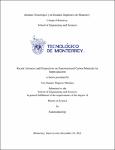| dc.contributor.advisor | Rodríguez Macías, Fernando Jaime | |
| dc.contributor.author | Higuera Martinez, Jose Ramiro | |
| dc.creator | Pérez González, Víctor Hugo; 349700 | |
| dc.date.accessioned | 2022-11-17T22:55:52Z | |
| dc.date.available | 2022-11-17T22:55:52Z | |
| dc.date.issued | 2021-11-30 | |
| dc.identifier.citation | Higuera Martinez, J. R., (2021). Recent advances and perspectives on nanostructured carbon materials for supercapacitors (Tesis Maestría). Instituto Tecnológico y de Estudios Superiores de Monterrey. Recuperado de: https://hdl.handle.net/11285/649905 | es_MX |
| dc.identifier.uri | https://hdl.handle.net/11285/649905 | |
| dc.description | 123571 | es_MX |
| dc.description | https://orcid.org/0000-0002-4319-5608 | es_MX |
| dc.description.abstract | Supercapacitors are an important part of the electrical components market, as both current dampener, and as energy storage devices. Making carbon based supercapacitors is a still growing area of research, as carbon devices have shown to produce a wide range of results by modifying the chemical composition and nanostructure of carbon, as well as doping, and using different allotropes. This can, in principle, allow the improvement of experimental parameters desired from carbon supercapacitors, such as high power and energy density, as well as long-lasting devices with higher capacitance than traditional capacitors.
Many approaches have been developed to optimize these experimental parameters by either the modification of the synthesis or the manufacturing process of the material, as a result, the variety of available options that can be explored has grown exponentially. Here, we present a review that summarizes the main mechanisms by which carbon supercapacitors work, the main modifications done to them, and the main carbon structures reported in the literature, present an overview of the latest advancements and emphasizing ones that seem to be giving better results. From this analysis, we can conclude that carbon has yet to achieve the highest capacitance results seen with other materials, but it has a definite advantage in the flexibility in production methods as well as in power and energy density. We can see that novel carbon structures present new opportunities to close the gap in capacitance and could take the lead in wearable and flexible supercapacitors. | es_MX |
| dc.format.medium | Texto | es_MX |
| dc.language.iso | eng | es_MX |
| dc.publisher | Instituto Tecnológico y de Estudios Superiores de Monterrey | es_MX |
| dc.relation | CONACYT A1-S-43933 (F.J.R.M.) | es_MX |
| dc.relation.isFormatOf | draft | es_MX |
| dc.relation.isreferencedby | REPOSITORIO NACIONAL CONACYT | |
| dc.rights | openAccess | es_MX |
| dc.rights.uri | http://creativecommons.org/licenses/by/4.0 | es_MX |
| dc.subject.classification | INGENIERÍA Y TECNOLOGÍA::CIENCIAS TECNOLÓGICAS::INGENIERÍA Y TECNOLOGÍA QUÍMICAS::CARBONO | es_MX |
| dc.subject.lcsh | Science | es_MX |
| dc.title | Recent advances and perspectives on nanostructured carbon materials for supercapacitors | es_MX |
| dc.type | Tesis de Maestría / master Thesis | es_MX |
| dc.contributor.department | Escuela de Ingeniería y Ciencias | es_MX |
| dc.contributor.committeemember | Pérez González, Víctor Hugo | |
| dc.contributor.mentor | Martínez Chapa, Sergio Omar | |
| dc.identifier.orcid | https://orcid.org/0000-0002-7100-6149 | es_MX |
| dc.subject.keyword | Nanocarbon | es_MX |
| dc.subject.keyword | Review | es_MX |
| dc.subject.keyword | Supercapacitor | es_MX |
| dc.subject.keyword | Carbon | es_MX |
| dc.subject.keyword | Nanostructure | es_MX |
| dc.contributor.institution | Campus Monterrey | es_MX |
| dc.contributor.cataloger | emipsanchez | es_MX |
| dc.description.degree | Maestro en Nanotecnologia | es_MX |
| dc.identifier.cvu | 935380 | es_MX |
| dc.date.accepted | 2021-12-06 | |
| dc.audience.educationlevel | Investigadores/Researchers | es_MX |
| dc.identificator | 7||33||3303||230305 | es_MX |



